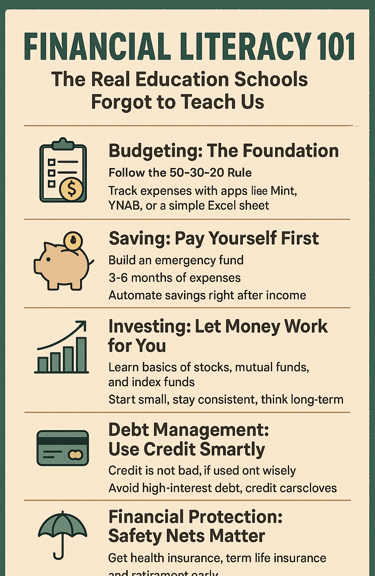“Financial Literacy 101: The Real Education Schools Forgot to Teach Us”
Schools teach algebra and history, but not how to budget, invest, or manage debt. Discover the basics of financial literacy—the real-world education every person needs.
RAVINDRA PRAJAPATI (EDUCATIONAL BLOG)
10/3/20252 min read


Introduction: The Education Gap
We spent years solving equations, memorizing dates, and writing essays—but no one taught us how to file taxes, create a budget, or manage debt. That missing subject is called Financial Literacy, and it’s the education system’s biggest blind spot.
Today, in a world of rising costs, digital payments, and financial uncertainty, money knowledge is not optional—it’s survival.
This blog is your Financial Literacy 101 guide: the real-world education schools forgot to give you.
What is Financial Literacy?
Financial literacy is the ability to understand and manage personal finances effectively.
It includes:
Budgeting → Tracking income and expenses.
Saving → Building financial security.
Investing → Growing wealth over time.
Debt Management → Using credit wisely.
Financial Protection → Insurance and emergency planning.
In simple words: financial literacy is learning how to make, manage, and multiply money.
Why Schools Failed Us
Why didn’t schools teach this? Because:
Old Curriculums – Education focuses on traditional subjects, not life skills.
Cultural Taboo – Money talk is avoided in many societies.
Assumption Gap – Schools assume families will teach money basics (but most don’t).
The result? Millions graduate without knowing how to handle their first paycheck, avoid debt traps, or save for the future.
Financial Literacy Basics Everyone Should Master
1. Budgeting: The Foundation
Follow the 50-30-20 Rule:
50% needs, 30% wants, 20% savings/investing.
Track expenses with apps like Mint, YNAB, or a simple Excel sheet.
2. Saving: Pay Yourself First
Build an emergency fund (3–6 months of expenses).
Automate savings right after income.
3. Investing: Let Money Work for You
Learn basics of stocks, mutual funds, and index funds.
Start small, stay consistent, think long-term.
4. Debt Management: Use Credit Smartly
Credit is not bad—it’s powerful if used wisely.
Avoid high-interest debt (credit cards, payday loans).
5. Financial Protection: Safety Nets Matter
Get health insurance, term life insurance, and retirement planning early.
Protection keeps wealth from collapsing in crises.
How to Build Your Financial Literacy Today
Read smart money books (e.g., Rich Dad Poor Dad, The Psychology of Money).
Follow finance blogs & podcasts for real-world tips.
Practice daily—budgeting, saving, and reviewing.
Start small investments and learn through experience.
Talk about money—with family, friends, or mentors.
Final Thoughts:
Financial literacy is the life skill schools never taught us but everyone needs. Without it, even a high salary can vanish. With it, even modest income can grow into wealth.
It’s not about knowing everything—it’s about knowing the basics, practicing them daily, and growing step by step.
💡 If schools forgot to teach you, don’t worry. You can start your Financial Literacy 101 journey today—and become your own money teacher.
RAVINDRA PRAJAPATI, Not a sebi registered
FOLLOW Us
ravindra.prajapati1122@gmail.com
+91 9795187745
© 2025. PiPiFinTech All rights reserved.
Contact Us
ABOUT Us
Our mission is to empower you to maximize every single penny and best solution for wealth generation and management for every mature age group.
Product TOPICS
Digital E-Wealth Platform
Mutual Funds
Education Planning
Insurance
FD and Bonds
Retirement Planning
Wealth Creation
(Disclaimers : Mutual Fund investments are subject to market risks, please read scheme related documents carefully.)
